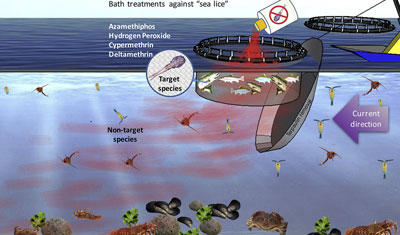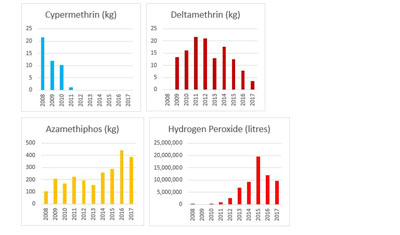Bath treatments are widely used on Scottish salmon farms to treat sea lice, a common parasite, and can be used as an alternative to adding pharmaceuticals to fish feed. Our last blog looked at the use of SLICE®, a pharmaceutical containing the active ingredient emamectin benzoate, commonly added to fish feed for this reason[1]. The use of alternative pharmaceuticals in bath treatments may increase as sea lice become less sensitive to emamectin benzoate, or if regulations around its use change, but are we getting into hot water with bath treatments?
Bath treatment methods
Two slightly different methods can be used for bath treatments. The less conventional method is onboard well-boats, with the fish suctioned into the well of a boat, treated with pharmaceuticals, and released back into their pen. The pharmaceuticals are discharged from the boat once treatment is complete and disperse into the surrounding water.
The second, more common method involves enclosing a net pen with a tarpaulin, then bathing the fish with the pharmaceutical (Figure 1). After treatment, the pharmaceuticals are also released into the surrounding water, where they are diluted and dispersed. Bath treatment plumes have been recorded to extend up to 8 km in length[2]. In Scotland, modelling studies by the regulator, the Scottish Environment Protection Agency (SEPA), are used to estimate how quickly chemicals become diluted. For a specific chemical, the predictions of the model are compared with the Environmental Quality Standard (EQS), and whether multiple treatments in a short time would breach the EQS[3]. EQS is the amount of pollutant allowed in a water environment and is set by SEPA.

Figure 1: Graphic showing tarpaulin bath treatments against sea lice: from Urbina et al (2019)[4].
In Scotland there are 4 chemicals currently licensed for this use, with 3 (cypermethrin, deltamethrin, azamethiphos) having Environmental Quality Standards (EQS), meaning the amount of chemical and the frequency with which they are used is limited. This is designed to minimise the impact the chemicals will have on the environment, in particular non-target species.
However, one treatment that is commonly used, hydrogen peroxide, does not have an EQS as it is believed to degrade quickly once in the environment and have no adverse effects on ‘non-target’ species. ‘Non-target’ animals are any marine organisms that are not sea lice, the intended target of the medicines. Cypermethrin has not been in use since 2011, and the use of deltamethrin is declining, due to a loss of effectiveness and supply issues, while the use of both azamethiphos and hydrogen peroxide have generally increased (Figure 2).

Figure 2: Chemicals used in Scottish aquaculture sea lice bath treatments, 2008-2017.
Impacts on organisms vary
Deltamethrin is a synthetic pyrethroid[5]. It targets the pre-adult and adult stages of sea lice by acting on the nervous system and has a greater effect on crustaceans than on fish or mammals. In the environment it has a very low solubility, however once settled on the seabed it shows rapid absorption and ’degrades’, or breaks down, with a marine sediment half-life of 140 days.
Azamethiphos is an organophospate which similarly targets pre-adult and adult stages of sea lice via the nervous system, being particularly effective on crustaceans [6].
However, it is highly soluble with a relatively short 9 day half-life in comparison to the pyrethroids already mentioned. Lobster larvae were used to calculate the EQS, and it is taken as being low risk due to rapid degradation.
Hydrogen peroxide targets adult sea lice through paralysis, cell damage and enzyme[7] inactivation, and is not species specific. It degrades to water and oxygen by 67% at 15oC after 7 days and is considered low risk[8].
Levels can build up in sediments
The rate at which any of these chemicals breaks down depends on several physical factors, such as the water pH and temperature, how easily the compound dissolves and how reactive it is[9]. Also, there may be other compounds in addition to the active ones in the medicines which may stay in the environment for a period of time, with unknown results. Laboratory experiments are used to estimate the length of time needed for degradation in the environment, but this can often be more than the actual length of time taken in the natural environment[9] .
Sea lice medicines that settle onto the sea floor undergo physical and biological processes. They may either be transported away by currents near the sea bed, or may be deposited in heavily enriched sediments where conditions can mean they are retained indefinitely[10]. Burrowing animals may bury compounds deeper into the sediment or ingest them and pass them out in their faeces. These and other ‘non-target’ animals may be affected by the medicinal chemicals.
Little knowledge of bioaccumulation and food chain transfers
Some chemicals can gradually build up in animals, or ‘bioaccumulate’, but little is known about these bath treatment chemicals and any effects their bioaccumulation would have on food chains[11]. Estimates are made using the rates of degradation and how long a chemical persists in the sediment or in non-target species’ bodies. A study on the effects of pyrethroids on farmed salmon concluded that levels of cypermethrin and deltamethrin found in sample fish were below the Acceptable Daily Intake (ADI) for humans[12]. At the moment there is no evidence that the chemicals being used are building up in animals and along food chains, but more research is urgently needed as the amounts of chemicals used increase.
Clear evidence of negative effects on non-target species
However, one of the main environmental concerns about sea lice chemical treatments is the toxicity to non-target species. A recent review of studies on the 4 chemicals used in bath treatments in Scotland found clear evidence of negative effects on non-target species3. For most of the non-target organisms studied, the concentrations recommended by the manufacturers were found to be above levels that caused 50% mortality, i.e. killed half of the population. Animals that weren’t killed often suffered a reduced ability to move or swim, making them less able to catch food and keep their position in the water. As many of these organisms are fed on by other animals this could have negative effects throughout marine food chains in coastal areas. Other effects included reduced reproduction, changes in gill structure and a generally weaker immune system.
Extensive research is still required to fully understand the effects of these chemicals on non-target species, especially as they can vary due to the concentrations used, the time and frequency of exposure, environmental conditions such as water temperature, salinity and pH, and also the species and its stage of development[4]. In addition, the exposure to more than one chemical should be evaluated, as there is no co-ordination on the application of these pharmaceuticals between different salmon farms within one loch, for example. The real effects of these chemicals on the marine environment is still largely unknown, and their use could affect several non-target species in the areas where they are in use.
Time for a chemical-free outlook
The loss of effectiveness for both azamethiphos and hydrogen peroxide for treatment of sea lice has already been reported in Norway[13]. Early results from ongoing research also suggests that hydrogen peroxide may have significant impacts on marine plants and animals at the concentrations used for treatments[14] [15]. The Norwegian regulators have a ban on its use, begging the question why isn’t Scotland following suit, or at least considering developing an EQS[16]?
Organic farming and its requirement for low chemical use may be seen as one way of dealing with the issue of pharmaceuticals, however very few farms in Scotland hold this certification and despite some new farms recently starting production, numbers have been decreasing overall. The Soil Association’s organic certification scheme presently allows 2 parasite treatments a year, on the condition that organophosphates or avermectins such as emamectin benzoate are not used[17].
The use and development of alternative non-chemical treatments needs to increase, such as the use of sea lice skirts, hydrolicers or cleaner fish [18]. It is indeed time for a chemical-free outlook.
[1] https://www.bestfishes.org.uk/chemicals-in-salmon-farming-part-i-does-slice-emamectin-benzoate-still-make-the-cut/
[2] Page F.H., and Burridge, L. (2014). Estimates of the effects of sea lice chemical therapeutants on non-target organisms associated with releases of therapeutants from tarped net-pens and well-boat bath treatments: a discussion. Canadian Science Advisory Secretariat (CSAS) Research Document 2014/103. Fisheries and Oceans Canada, New Brunswick, 41 pp.
[3] SEPA (2008b). Regulation and monitoring of marine cage fish farming in Scotland – a procedures manual. Annex G: Models for assessing the use of chemicals in bath treatments v2.2. SEPA, Stirling, 16 pp.
[4] Reprinted from Science of the Total Environment, 649, Urbina, M.A. et al. Effects of pharmaceuticals used to treat salmon lice on non-target species: Evidence from a systematic review, 1124-1136; 2019. https://www.sciencedirect.com/science/article/pii/S0048969718333059#f0005
[5] Synthetic pyrethroids are pesticides derived from naturally occurring pyrethrins, taken from pyrethrum of dried Chrysanthemum flowers. http://pubs.sciepub.com/aees/1/3/2/
[6] Organophosphates are a class of chemicals that inhibit an important neurotransmitter in the nerve terminal, highly toxic to insects but less so to humans and domestic animals. https://www.sciencedirect.com/topics/neuroscience/organophosphates
[7] Enzymes help speed up chemical reactions in the body. They affect every function, from breathing to digestion.
[8] SAMS (2018) Review of the Environmental Impacts of Salmon Farming in Scotland. 02468_0001, Issue 01, 24\01\2018. https://www.parliament.scot/S5_Rural/Inquiries/20180125_SAMS_Review_of_Environmental_Impact_of_Salmon_Farming_-_Report.pdf
[9] Boxall, A.B.A. et al.(2003). Are veterinary medicines causing environmental risks? Environmental Science and Technology, 37: 286A-294A. https://pubs.acs.org/doi/pdf/10.1021/es032519b?rand=bg7u5i8v
[10] Burridge, L. et al. (2010). Chemical use in salmon aquaculture: A review of current practices and possible environmental effects. Aquaculture, 306, 7-23. https://www.sciencedirect.com/science/article/abs/pii/S0044848610003297
[11] Brooks, S.J. et al (2018) Bioaccumulation of selected veterinarymedicinal products (VMPs) in the
blue mussel (Mytilus edulis). Science of the Total Environment, 655, 1409–1419. https://www.sciencedirect.com/science/article/pii/S0048969718345686
[12] Aznar-Alemany, Ó. et al.(2017) Effect of pyrethroid treatment against sea lice in salmon farming regarding consumers’ health. Food and Chemical Toxicology, 105, 347-354. https://www.sciencedirect.com/science/article/pii/S0278691517302132?via%3Dihub
[13] Aaen, S.M. et al (2015) Drug resistance in sea lice: a threat to salmonid aquaculture. Trends in Parasitology, 31, 72–81. https://www.cell.com/trends/parasitology/fulltext/S1471-4922(14)00209-8?_returnURL=https%3A%2F%2Flinkinghub.elsevier.com%2Fretrieve%2Fpii%2FS1471492214002098%3Fshowall%3Dtrue
[14] Haugland, B.T. et al (2019) Mortality and reduced photosynthetic performance in sugar kelp Saccharina latissimi caused by the salmon-lice therapeutant hydrogen peroxide. Aquaculture Environment Interactions, 11, 1-17. https://www.int-res.com/articles/aei2019/11/q011p001.pdf
[15] Bechmann, R.K. et al. (2019) Gill damage and delayed mortality of Northern shrimp (Pandalus borealis) after short time exposure to anti-parasitic veterinary medicine containing hydrogen peroxide. Ecotoxicology and Environmental Safety, 180, 473-482. https://www.sciencedirect.com/science/article/pii/S014765131930586X?via%3Dihub
[16] https://www.fishfarmingexpert.com/article/norway-bans-tarpaulin-bath-treatments-near-shrimp/
[17] https://www.soilassociation.org/media/18614/aquaculture-standards.pdf
[18] https://globalsalmoninitiative.org/en/what-is-the-gsi-working-on/biosecurity/non-medicinal-approaches-to-sea-lice-management/
Tags: azamethiphos, bath treatment, cypermethrin, deltamethrin, hydrogen peroxide, Norway, organophosphate, pyrethroid, salmon, salmon farming, Scotland, Scottish salmon, sea lice

